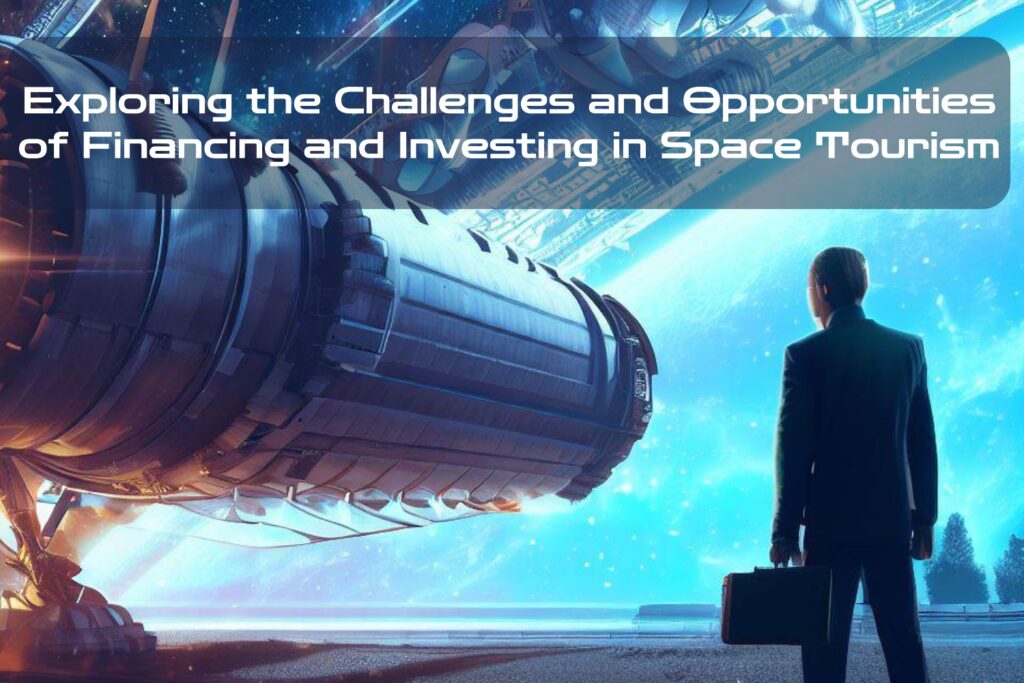Financing and Investing in Space Tourism
Exploring the Excitement of Space Tourism
As children, many of us dreamed of traveling to the stars. Today, thanks to advances in technology, space tourism is no longer a distant fantasy. Instead, it’s a rapidly growing industry that promises to take people on journeys beyond our planet.
Over the past few years, we’ve seen significant interest from private investors and corporations looking to capitalize on this emerging market. With new players entering the industry every day and existing companies expanding their offerings, it’s an exciting time for space enthusiasts.
However, as with any new venture, funding and investing in space tourism comes with its own set of challenges and opportunities. In this article, we’ll explore both sides of this growing field and what they mean for those interested in financing or investing in space tourism.
Taking on the Challenges
While the idea of flying into space may seem like a dream come true for many people around the world, bringing that dream to reality requires significant funding and investments. One of the primary challenges facing companies looking to enter this market is raising enough capital to cover their upfront costs. Infrastructure development can be costly – designing vehicles capable of leaving our planet’s gravity well is no small expense.
The technology required to make these flights safe is still being developed, which adds an extra layer of complexity. Another challenge lies in forecasting demand for space tourism – there are still questions about how many people will be willing or able to pay for such an experience.
Given that there are currently only a few approved operators offering complete packages for suborbital flights (Blue Origin’s crewed New Shepard rocket being one), public interest may not yet be at full capacity when it comes to these types of flights, despite ample public excitement.
Regulatory hurdles present additional challenges.
Because space travel involves risks unique to the environment, governments are still figuring out how to safely and effectively regulate this industry. There also remains uncertainty regarding liability in cases of space tourism accidents or injuries.
Seizing the Opportunities
Despite these challenges, there are several opportunities available for those interested in financing or investing in space tourism. One of the primary drivers is the potential for high returns on investment. Given that space tourism is a relatively new market, there is still significant room for growth as interest continues to rise.
In addition to private investors, governments and corporations have shown increasing interest in funding and developing space tourism infrastructure. For example, NASA has been working with commercial companies such as SpaceX on projects like sending crewed missions to the International Space Station (ISS).
Moreover, some corporations like Virgin Galactic have already opened up direct public offerings so everyday folks can invest directly into their company.
Another compelling aspect of investing in space tourism lies in possible spin-off technologies that could have broader applications beyond just travel-related industries.
Examples include new materials science research opportunities or other advances related to being able to work off-world. Overall, despite challenges, this market also presents many exciting opportunities worth exploring.
The Challenges of Financing Space Tourism

High Upfront Costs for Infrastructure and Technology Development
One of the biggest challenges facing those looking to invest in space tourism is the sheer cost of developing the necessary infrastructure and technology. From building spaceports to designing spacecraft capable of carrying passengers, the upfront costs can be astronomical.
And that’s not even factoring in ongoing expenses such as maintenance, fuel, and staffing. These high costs can make it difficult for investors to see a return on their investment in a reasonable timeframe.
Uncertainty Around Demand and Profitability
Another major challenge facing potential investors in space tourism is the uncertainty surrounding demand for these services and whether they will be profitable in the long run. While there is certainly a growing interest in commercial space travel, it’s still unclear how many people are willing and able to pay for these experiences on a regular basis. Additionally, there are concerns about how much customers will be willing to pay given the high costs associated with space travel.
Regulatory Hurdles and Legal Considerations

There are significant regulatory hurdles and legal considerations that need to be taken into account when financing space tourism ventures. For example, companies looking to offer commercial flights will need to comply with regulations from multiple government agencies such as NASA, FAA, FCC etc..
There may also be legal challenges related to liability if something goes wrong during these flights or if passengers suffer injuries or illnesses while in orbit.
All of these factors can add additional costs and time delays, which make investors wary of investing large sums in this sector. Financing space tourism presents several significant challenges, such as high upfront costs for infrastructure design and technology development, coupled with uncertainty around demand for these services over time.
Investors must also navigate complex regulatory requirements while balancing the financial risks associated with investments made in this futuristic industry. Nevertheless, forward-thinking investors who are willing to take risks stand to reap significant financial benefits as they help establish this new market that is gaining momentum.
Opportunities for Financing Space Tourism

Potential for high returns on investment as a new market emerges
One of the main reasons investors are interested in financing space tourism is the potential for high returns on their investments. As space tourism is still a relatively new industry, there is a lot of room for growth and innovation.
In fact, according to estimates by UBS, the space tourism market could be worth $3 billion annually by 2030, which represents a huge opportunity for investors who get in early. The key to success in this industry will be to invest in companies that have a strong vision and long-term strategy.
Companies that are developing innovative technologies or creating unique experiences will be more likely to succeed than those that simply offer standard suborbital flights. Those companies that are able to establish themselves as leaders in the industry early on will also be better positioned to capture market share once the industry begins to mature.
Growing interest from private investors, governments, and corporations

Another reason there are opportunities for financing space tourism is the growing interest from private investors, governments, and corporations. Space tourism is no longer just the domain of government agencies such as NASA; private companies like SpaceX and Blue Origin are now leading the way in developing new technologies and offering commercial space flights.
Governments around the world are also getting involved in this emerging market, with countries like China investing heavily in their own space programs. This investment not only creates opportunities for local businesses but also helps stimulate innovation and growth across many different sectors.
Large corporations such as Virgin Galactic are investing significant resources in developing their own commercial space programs. These companies have deep pockets and can help drive innovation forward by providing funding and know-how.
Possibility for spin-off technologies with broader applications

One final reason why there are opportunities for financing space tourism is the possibility of spin-off technologies with broader applications. Many of the technologies being developed for space travel have potential applications in other industries such as healthcare, transportation, and energy. For example, lightweight materials and advanced propulsion systems being developed for spacecraft could be used to create more fuel-efficient cars or airplanes.
Medical research conducted in zero gravity environments could lead to breakthroughs in the treatment of diseases like cancer. Investing in companies that are developing these spin-off technologies can be a smart way to diversify a portfolio while also contributing to the growth and innovation of multiple industries.
Investing in Space Tourism: Key Considerations

Understanding the market landscape and competitive dynamics
Before investing in space tourism, it is essential to understand the industry’s market landscape and its competitive dynamics. The space tourism industry is relatively new, with only a few players currently offering services.
However, several new companies are emerging, making it an exciting time for investors to get involved. It is also important to consider the target market for space tourism.
Currently, it primarily caters to ultra-wealthy individuals willing to pay exorbitant prices for a unique experience. However, as technology advances and costs decrease, there may be opportunities to expand into broader markets.
Evaluating different business models (e.g., suborbital flights, orbital hotels)

When evaluating different business models in space tourism investment, there are two primary options: suborbital flights and orbital hotels.
Suborbital flights offer short-duration trips above the Earth’s atmosphere before returning to Earth.
These flights are less expensive than orbital hotels but still offer a unique experience.
Orbital hotels would provide guests with longer stays in space by orbiting around Earth.
This type of venture requires significant investment but has enormous potential for growth as it offers extended stays in space with more amenities than suborbital flights. It is important to assess which model aligns best with your investment goals and risk tolerance.
Assessing risks associated with technological development, launch operations, and customer safety

As with any investment opportunity, there are risks associated with financing and investing in space tourism. Technological development poses a significant risk as it requires significant capital investments that may not yield positive returns if the technology does not work out as planned.
Launch operations pose another potential risk factor due to their inherent complexities involving rockets and fuel requirements. A single mishap could damage both equipment and customer confidence.
Customer safety is a crucial consideration for any space tourism venture. Space tourism companies must prioritize safety protocols and risk management to maintain customer trust and avoid costly lawsuits.
Investing in space tourism entails significant risks but also offers tremendous opportunities for growth as a new market emerges. Understanding the market landscape, evaluating different business models, and assessing associated risks are essential considerations before committing to this exciting opportunity.
The Role of Government Funding in Space Tourism Development

When it comes to financing and investing in space tourism, one major player is governments. Countries around the world are recognizing the potential economic benefits of space tourism and are investing significant amounts of money into developing necessary infrastructure and technology.
In fact, according to a report by the Tauri Group, governments accounted for 77 percent of investments in commercial space activities between 2000 and 2018. The role of government funding in space tourism development is twofold.
First, it helps to support the initial research and development necessary to create viable commercial space tourism ventures. Second, government involvement can also help to mitigate some of the risks associated with investing in a nascent industry.
For example, NASA provides insurance coverage through its Launch Services Program for payloads on commercial rockets. However, government funding can also come with strings attached.
Regulations and bureaucratic processes can slow down progress and add additional costs to projects. Additionally, reliance on government funding can make companies vulnerable if political priorities shift or funding sources dry up.
The Emergence of Private Spaceports as Investment Opportunities

Another aspect of financing and investing in space tourism is the emergence of private spaceports as investment opportunities. With more companies entering the market, there is a growing need for launch facilities that cater specifically to commercial ventures rather than just government missions. Several private companies have already established their own spaceports or are partnering with existing facilities to provide launch services tailored specifically for commercial customers.
Examples include Blue Origin’s Launch Site One in Texas and SpaceX’s Boca Chica launch site in Texas. Investing in private spaceports offers several advantages.
It allows investors to tap into multiple revenue streams: not only from launching their own rockets but also from leasing out facilities for other companies’ launches. Additionally, owning or partnering with a spaceport can give companies more control over scheduling launches and potentially reduce costs associated with having to rely on third-party launch providers.
The Residual Impact of COVID on the Space Tourism Industry

Of course, no discussion of financing and investing in space tourism would be complete without considering the impact of COVID-19. The pandemic has had a significant impact on the travel and hospitality industries as a whole, and space tourism is no exception. Space tourism companies have had to delay or postpone launches due to travel restrictions and safety concerns.
Virgin Galactic had to postpone their planned commercial launch until 2022 due, in part, to difficulty scheduling test flights during the pandemic. On the other hand, COVID-19 has also highlighted some potential opportunities for space tourism. If not directly from this last pandemic itself, certainly now an awareness of global factors perhaps not previously given much credence.
Conversely, with more people working remotely, there may be increased demand for unique experiences that allow individuals to escape their everyday lives. Additionally, with concerns about crowded airports and airplanes, private spaceflight could become an even more attractive option for those willing to pay a premium for safety and exclusivity.
Overall, it remains to be seen how much of an impact COVID-19 will have on the future of space tourism. However, investors should be aware of both the potential risks and opportunities associated with investing in an industry that is still very much in its early stages.
Taking the Plunge into Space Tourism Investing

Throughout this article, we’ve explored the challenges and opportunities involved in financing and investing in the rapidly growing industry of space tourism. From high upfront costs to regulatory hurdles, there are undoubtedly significant obstacles to overcome.
However, for those willing to take risks and invest in this emerging market, there are also exciting opportunities for high returns on investment. One key takeaway from this discussion is that government funding has played a significant role in advancing space tourism development thus far.
However, private investors are increasingly stepping up to fund space-related ventures, including startup companies and infrastructure projects. As more private funding pours into the industry, the pace of technological development is likely to accelerate even further.
Another important consideration for those looking to invest in space tourism is choosing the right business model. Suborbital flights and orbital hotels are just two examples of potential models that have garnered interest from investors and entrepreneurs alike.
Ultimately, choosing a business model that aligns with your values and investment goals will be crucial to success. While it may seem daunting to invest in an industry as complex as space tourism, there are certainly compelling reasons to consider doing so.
With advancements in technology continuing at a breakneck pace and growing interest from both private investors and governments alike, now may be an opportune time to get involved. By carefully weighing risks against potential rewards and staying abreast of developments within the industry as they unfold, investors can position themselves for success in this exciting new frontier of human exploration.
TL;DR … Factors addressed above
– 🚀 High upfront costs for infrastructure and technology development
– 💰 Uncertainty around demand and profitability
– 📝 Regulatory hurdles and legal considerations
– 💼 Potential for high returns on investment as a new market emerges
– 👥 Growing interest from private investors, governments, and corporations
– 🔬 Possibility for spin-off technologies with broader applications
– 🌍 Understanding the market landscape and competitive dynamics
– 🏨 Evaluating different business models (e.g., suborbital flights, orbital hotels)
– ⚠️ Assessing risks associated with technological development, launch operations, and customer safety
– 🏢 The role of government funding in space tourism development
– 🛫 The emergence of private spaceports as investment opportunities
– 🌐 The residual impact of COVID on the space tourism industry
– 🌌 Taking the plunge into space tourism investing

C M, a seasoned editor, journalist, and consultant, is deeply fascinated by the convergence of technology, space, and the future of humanity.
With a particular interest in transhumanity, futurology, and the philosophical and ethical dimensions of these domains, C M serves as the lead contributor to SpaceSpotlight and TranscendSphere.
When not penning insightful articles on these rapidly evolving fields, C M indulges in their love for podcasts and books, proudly embracing their status as a ‘Happy Nerd Extraordinaire!’



